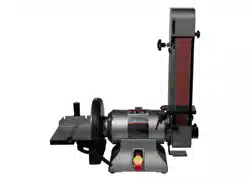Loading ...
Loading ...
Loading ...

10
6.0 Setup and assembly
6.1 Tools required for assembly
Cross-point (Phillips) screwdriver
3mm hex wrench – provided
6mm hex wrench – provided
Additional tools may be needed for securing sander
to a stand or workbench.
6.2 Unpacking
Separate all parts from the packing material. Check
each part against sect. 5.0, Carton contents, and
make certain that all items are accounted for.
(Check whether any parts have been pre-mounted
to the grinder.) Notify your dealer or JET if missing
or damaged items are discovered. Do not discard
packing material until grinder is assembled and
operating properly.
The IBDG Belt and Disc Sander requires minimal
assembly. For your safety, do not plug the sander
into a power source until all assembly and
adjustments are complete.
Make sure that sander is
unplugged and power switch is in OFF position.
Do not plug in the sander to power until it is
inspected for shipping damage and all
necessary assembly and adjustments are
performed. Failure to comply may cause serious
injury.
Do not operate this machine
without all guards and shields in place and in
working order. Failure to comply may cause
serious injury.
6.3 Securing the sander
To prevent the machine from moving during
operation, it should be securely mounted to a work
bench or stand. Fasteners for mounting are not
included with the sander.
1. Align mounting holes on sander with predrilled
holes in bench or pedestal. Figure 4-1 shows
hole centers for mounting.
2. Insert M10 (or 3/8”) bolts through the holes and
secure with washers and nuts.
An optional JET pedestal stand (not included) is
available for your sander. See sect. 11.0.
IMPORTANT: The sander’s base plate contains
ventilation holes for heat dissipation. This is
especially important on the variable speed models,
as it helps keep the circuit board at an acceptable
temperature. These holes should not be obstructed.
If the rubber pads are removed for mounting to a
table, allow an opening in the table below the grinder
for air circulation. However, it is recommended the
rubber pads be left on, as they allow air circulation
as well as vibration dampening.
6.4 Belt sanding table
Install bracket plate, table and handles, as shown in
Figure 6-1. (You may prefer sanding arm in
horizontal position for this – see Figure 6-3.)
Figure 6-1: sanding belt table
TIP: The quickest method of installing a handle is to
start the handle into the threads of the hole, then pull
out on the handle while turning the screw with a
3mm hex wrench until tight. See Figure 6-2.
To reposition a handle for convenience without
affecting its tightness, pull out on it, rotate, then
release it, allowing it to resettle upon the screw.
Figure 6-2: installing handles
To avoid trapping the work or
fingers between table and sanding belt, the table
edge must be positioned 1/16-inch or less from
the sanding belt.
6.5 Stand-off
1. Install stand-off (shown installed in Figure 8-2)
into threaded hole in back of sanding arm.
2. Loosen screw (A, Figure 6-3) with 6mm hex
wrench and lower sanding arm to horizontal
position.
3. Turn stand-off in or out as needed until sanding
arm is level with workbench.
4. Tighten hex nut against sanding arm to secure
setting of stand-off.
Loading ...
Loading ...
Loading ...
